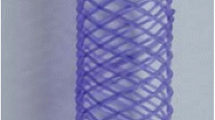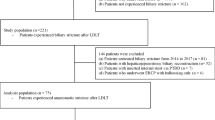Abstract
Purpose
The aim of this study was to evaluate the safety and the effectiveness of polydioxanone-made biodegradable biliary stent placement for the treatment of post-transplant benign, refractory biliary anastomotic strictures.
Materials and Methods
This was a retrospective observational study on all adult liver transplant recipients who developed a clinically significant anastomotic stricture between January 2014 and June 2017. Percutaneous transhepatic cholangioplasty with balloon dilation was performed as therapeutic approach in selected patients after multidisciplinary evaluation. Refractory strictures (defined as stricture persistence after two interventional procedures) were managed with placement of polydioxanone-made biodegradable biliary stent (SX-Ella biliary stent, Czech Republic). Patency of the common bile duct was calculated using Kaplan–Meier analysis.
Results
Eighteen adult liver transplant recipients who developed a refractory biliary anastomotic stricture [males/females 13/5, median (IQR) 58.2 (9.3) years] underwent biodegradable biliary stent placement after 10.4 (32) months from liver transplantation. All procedures except one were uneventful. After a median (IQR) follow-up time of 27.2 (22) months, complete resolution of anastomotic stricture was achieved in 72% of patients, with significant improvement on liver enzymes.
Conclusions
Polydioxanone-made biodegradable biliary stent might be a safe and effective therapeutic option for the difficult-to-treat benign biliary anastomotic stricture after liver transplantation.






Similar content being viewed by others
Abbreviations
- AS:
-
Anastomotic stricture
- BBS:
-
Biodegradable biliary stent
- ERCP:
-
Endoscopic retrograde cholangiopancreatography
- LT:
-
Liver transplantation
- MRCP:
-
Magnetic resonance cholangiopancreatography
- PDX:
-
Polydioxanone
- PTC:
-
Percutaneous transhepatic cholangioplasty
References
Seehofer D, Eurich D, Veltzke-Schlieker W, Neuhaus P. Biliary complications after liver transplantation: old problems and new challenges. Am J Transplant. 2013;13(2):253–65.
Verdonk RC, Buis CI, Porte RJ, van der Jagt EJ, Limburg AJ, van den Berg AP, et al. Anastomotic biliary strictures after liver transplantation: causes and consequences. Liver Transplant. 2006;12(5):726–35.
Sundaram V, Jones DT, Shah NH, de Vera ME, Fontes P, Marsh JW, et al. Posttransplant biliary complications in the pre- and post-model for end-stage liver disease era. Liver Transplant. 2011;17(4):428–35.
Landi F, de’Angelis N, Sepulveda A, Martínez-Pérez A, Sobhani I, Laurent A, et al. Endoscopic treatment of anastomotic biliary stricture after adult deceased donor liver transplantation with multiple plastic stents versus self-expandable metal stents: a systematic review and meta-analysis. Transpl Int. 2018;31(2):131–51.
Aparício DPDS, Otoch JP, Montero EFS, Khan MA, Artifon ELA. Endoscopic approach for management of biliary strictures in liver transplant recipients: a systematic review and meta-analysis. United Eur Gastroenterol J. 2017;5(6):827–45.
Holt AP, Thorburn D, Mirza D, Gunson B, Wong T, Haydon G. A prospective study of standardized nonsurgical therapy in the management of biliary anastomotic strictures complicating liver transplantation. Transplantation. 2007;84(7):857–63.
Cantù P, Tarantino I, Baldan A, Mutignani M, Tringali A, Lombardi G, et al. Endo-therapies for biliary duct-to-duct anastomotic stricture after liver transplantation: outcomes of a nationwide survey. Liver Int. 2019;39(7):1355–62.
Kim ES, Lee BJ, Won JY, Choi JY, Lee DK. Percutaneous transhepatic biliary drainage may serve as a successful rescue procedure in failed cases of endoscopic therapy for a post-living donor liver transplantation biliary stricture. Gastrointest Endosc. 2009;69(1):38–46.
Repici A, Vleggaar FP, Hassan C, van Boeckel PG, Romeo F, Pagano N, et al. Efficacy and safety of biodegradable stents for refractory benign esophageal strictures: the BEST (Biodegradable Esophageal Stent) study. Gastrointest Endosc. 2010;72(5):927–34.
Siiki A, Sand J, Laukkarinen J. A systematic review of biodegradable biliary stents: promising biocompatibility without stent removal. Eur J Gastroenterol Hepatol. 2018;30(8):813–8.
Stivaros SM, Williams LR, Senger C, Wilbraham L, Laasch HU. Woven polydioxanone biodegradable stents: a new treatment option for benign and malignant oesophageal strictures. Eur Radiol. 2010;20(5):1069–72.
Janík V, Horák L, Hnaníček J, Málek J, Laasch HU. Biodegradable polydioxanone stents: a new option for therapy-resistant anastomotic strictures of the colon. Eur Radiol. 2011;21(9):1956–61.
Mauri G, Michelozzi C, Melchiorre F, Poretti D, Tramarin M, Pedicini V, et al. Biodegradable biliary stent implantation in the treatment of benign bilioplastic-refractory biliary strictures: preliminary experience. Eur Radiol. 2013;23(12):3304–10.
Mauri G, Michelozzi C, Melchiorre F, Poretti D, Pedicini V, Salvetti M, et al. Benign biliary strictures refractory to standard bilioplasty treated using polydoxanone biodegradable biliary stents: retrospective multicentric data analysis on 107 patients. Eur Radiol. 2016;26(11):4057–63.
Dopazo C, Diez I, Quintero J, Curell A, González-Junyent C, Caralt M, et al. Role of biodegradable stents as part of treatment of biliary strictures after pediatric and adult liver transplantation: an observational single-center study. J Vasc Interv Radiol. 2018;29(6):899–904.
Siiki A, Rinta-Kiikka I, Sand J, Laukkarinen J. Endoscopic biodegradable biliary stents in the treatment of benign biliary strictures: first report of clinical use in patients. Dig Endosc. 2017;29(1):118–21.
Yamamoto K, Yoshioka T, Furuichi K, Sakaguchi H, Anai H, Tanaka T, et al. Experimental study of poly-l-lactic acid biodegradable stents in normal canine bile ducts. Cardiovasc Intervent Radiol. 2011;34(3):601–8.
Koksal AS, Eminler AT, Parlak E, Gurakar A. Management of biliary anastomotic strictures after liver transplantation. Transplant Rev (Orlando). 2017;31(3):207–17.
Sung RS, Campbell DA, Rudich SM, Punch JD, Shieck VL, Armstrong JM, et al. Long-term follow-up of percutaneous transhepatic balloon cholangioplasty in the management of biliary strictures after liver transplantation. Transplantation. 2004;77(1):110–5.
Author information
Authors and Affiliations
Corresponding author
Ethics declarations
Conflict of interest
The authors declare that they have no conflict of interest.
Ethical Standard
All procedures performed in this study were in accordance with the ethical standards of the institutional and national research committee and with the 1964 Helsinki Declaration and its later amendments or comparable ethical standards. The study was approved by the Institutional Review Board.
Informed Consent
Informed consent was obtained from all individual participants included in the study.
Consent for Publication
Consent for publication was obtained for every individual person’s data included in the study.
Additional information
Publisher's Note
Springer Nature remains neutral with regard to jurisdictional claims in published maps and institutional affiliations.
Electronic supplementary material
Below is the link to the electronic supplementary material.
Rights and permissions
About this article
Cite this article
Battistel, M., Senzolo, M., Ferrarese, A. et al. Biodegradable Biliary Stents for Percutaneous Treatment of Post-liver Transplantation Refractory Benign Biliary Anastomotic Strictures. Cardiovasc Intervent Radiol 43, 749–755 (2020). https://doi.org/10.1007/s00270-020-02442-4
Received:
Accepted:
Published:
Issue Date:
DOI: https://doi.org/10.1007/s00270-020-02442-4




